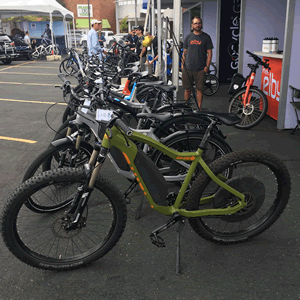The e-Bike Revolution is Coming
High-tech motor, charging, and sensor systems are making the new generation of e-bikes a viable part of the transportation picture.
By Amy Goetzman, Connector Supplier bike
At first, I didn’t see the point of an e-bike. Why would you want a motor to do the work for you? Getting exercise is half the point of bicycling, right? And then I rode one. Here’s what I learned: You still get exercise. An e-bike doesn’t do all the work for the rider. Instead, it assists the rider. If you need to go faster or further than your own power can carry you, or get up a steep hill, or get to work without breaking a sweat, the e-bike can supplement the momentum you generate with a boost of power from the motor.
“It feels very smooth and natural, like you have a tail wind behind you that picks up just when you’d like it to. Up until a few years ago, eBike technology felt more like a jolt. The latest e-bikes look and feel more and more like regular bicycles,” says Jonathan Weinert, sales and marketing manager for Bosch eBike Systems. Bosch’s pedal-assist technology, which includes the hub-mounted motor, battery, and onboard computer, is used by more than 70 brands of e-bikes, and the system is one of the factors that is making e-bikes a serious part of the transportation picture in Europe — a trend that is picking up speed in the US and other countries.
For people who are dealing with physical issues but still want to get out on a trail or ride to work, e-bikes enable them to continue the activities they enjoy. At the Electric Bike Expo, a traveling event that enables curious bicyclists to try e-bikes made from companies ranging from Trek to BMW, gray hair was out in force at its Minnesota stop this summer. But there were also plenty of younger bike enthusiasts checking out the cool new machines — and are they ever cool. The latest generation of high-tech e-bikes is responsive, fully integrated, long-ranging, stylish, and ready to transform the transportation landscape. In Europe, they’ve already made a big impact.
Weinart says Europeans buy two million e-bikes a year, with e-bikes accounting for one in every three bikes sold in the Netherlands and one in four in Germany. Right now, e-bikes account for only one in 100 bikes sold in the US, but that’s poised to change as new technology, combined with improving bike infrastructure, makes it an attractive alternative to highway congestion.
“Our cities are becoming so congested that we need to expand transportation options. The existing infrastructure simply cannot support this many cars. Plus, people are tired of spending so much time sitting in traffic. It really impacts quality of life,” says Weinert. “e-bikes make bicycling to work as well as for fun much more feasible for a lot more people.”
So What’s the Tech?
While variations of the e-bike have been available for years, the technology that enables e-bikes has undergone a dramatic change in just the past few years, says Weinert. Integrated LED lighting, lightweight lithium ion batteries, sophisticated sensors, and fast-charging technology have made the new machines safer and capable of speeds up to 28 miles per hour, over 100 miles of range, and with 3 ½ hours of power per charge. The current generation of e-bikes cost from $2,500-$4,000, and the price is coming down.
Most e-bikes operate with one of two main drive systems: a hub-mounted drive, in which the motor is located in the hub of the rear wheel, or a mid-drive system in which the motor is located between the pedals. These motors are interconnected with a system that includes lighting, sensors that monitor riding conditions, such as elevation, the amount of pressure the rider applies to the pedals, elevation, and remaining charge. A 36V lithium ion battery is typically integrated with the frame, where the water bottle would go, or by the rear wheel. Charging stations and auxiliary power packs are also available.
Most e-bike brands feature a digital display that shows speed, distance, remaining charge, level of assist — which can go up to 300%, essentially three times the power the human gives the machine — and other information calculated by onboard computers. In Europe, more advanced e-bikes also offer Bluetooth connections between the bike and phone, and anti-theft systems that include locking devices, trackers, alarms, and bike-to-phone communications.
A wide variety of COTS and specialized connectors unite these systems. Traditional choices for factory-made and DIY e-bikes include JST’s SM connectors for small signal wires and Anderson Power Product’s Powerpole® connectors for carrying currents. Deans Plugs are popular with DIY bike-building enthusiasts, XLR connectors are prized for their moisture resistance, and quick-lock (QL) connectors are a popular choice for factory-made e-bikes. Higo is exclusively devoted to e-bikes, and the company is the leading manufacturer of signal, battery, motor, main cable, and splitter connectors for e-bikes.
As this young industry develops, more opportunity will arise for e-bike-specific components. In the meantime, connectors and cables from other applications are getting the job done, particularly those designed for mil-aero, harsh environment, and automotive systems.
Weinert says the e-bike is a natural offshoot of the electric car. At least one car manufacturer, BMW, offers an electric bike. Weinert says a CAN-bus communications protocol adapted from automotive systems communicates with the battery in the Bosch system (attached with a proprietary connector). Other recent developments in the automotive world, including torque sensors, power steering, and read-outs that resemble those seen in electric cars, are now finding a place in e-bikes.
“The electric bike is following the lead of the electric car, and as we become familiar with the new rhythms of charging up instead of fueling up, the e-bike will seem a very natural transportation option,” says Weinert. “You’ll still get the benefits of biking — the heart benefits, the muscle benefits, and the head-clearing stress relief. But you’ll be able to go faster and further.”
- Meet the Connector: DIN Standard Connectors - April 16, 2024
- Software-Driven Radio Reinvigorates Old Technology - April 9, 2024
- What is a Busbar? - April 2, 2024






